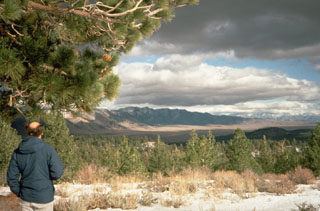Report on Long Valley (United States) — September 1989
Scientific Event Alert Network Bulletin, vol. 14, no. 9 (September 1989)
Managing Editor: Lindsay McClelland.
Long Valley (United States) Frequent seismicity continues
Please cite this report as:
Global Volcanism Program, 1989. Report on Long Valley (United States) (McClelland, L., ed.). Scientific Event Alert Network Bulletin, 14:9. Smithsonian Institution. https://doi.org/10.5479/si.GVP.SEAN198909-323822
Long Valley
United States
37.7°N, 118.87°W; summit elev. 3390 m
All times are local (unless otherwise noted)
Frequent seismicity continued through September beneath the SW flank of Mammoth Mountain (see figure 9). As of 30 September, 1,375 events had been recorded by the California Division of Mines and Geology NEWT system since the swarm began on 4 May. The September total rose slightly to 220 shocks, from 193 in August.
Strong bursts of seismicity occurred on 9 and 19 September (see figure 8). Most of the 42 events recorded on 9 September occurred during several strong bursts of spasmodic tremor and were centered at 4-9 km depth. On 19 September, the bulk of the 35 events were isolated and had focal depths of 2-12 km, nearly the full depth range of the May-September swarm. Other than the several shocks at 11-12 km on 19 September, there was no indication of systematic depth migration during the month. Low-frequency earthquakes were detected on 9, 19, and 21 September. Locations were similar to those of other swarm events, but they had emergent P-waves, lacked clear S-waves, and were of lower overall frequency content than other shocks of the same magnitude. In the epicentral area, the USGS MMP station generally recorded only 10-20 small (M < 0.5) events/day that were not detected by more distant instruments. Previous totals as high as several hundred events/day from this instrument (SEAN 14:07 and 14:08) have been recorded only during periods of high seismic activity. Although precise data from MMP were not available, the typical September daily values represented a severalfold decline from earthquake counts during analagous periods of relative seismic quiet in June and July.
Geological Summary. The large 17 x 32 km Long Valley caldera east of the central Sierra Nevada Range formed as a result of the voluminous Bishop Tuff eruption about 760,000 years ago. Resurgent doming in the central part of the caldera occurred shortly afterwards, followed by rhyolitic eruptions from the caldera moat and the eruption of rhyodacite from outer ring fracture vents, ending about 50,000 years ago. During early resurgent doming the caldera was filled with a large lake that left strandlines on the caldera walls and the resurgent dome island; the lake eventually drained through the Owens River Gorge. The caldera remains thermally active, with many hot springs and fumaroles, and has had significant deformation, seismicity, and other unrest in recent years. The late-Pleistocene to Holocene Inyo Craters cut the NW topographic rim of the caldera, and along with Mammoth Mountain on the SW topographic rim, are west of the structural caldera and are chemically and tectonically distinct from the Long Valley magmatic system.
Information Contacts: S. McNutt, California Division of Mines and Geology, Sacramento; D. Hill, USGS Menlo Park.

